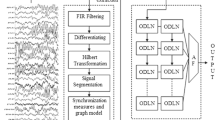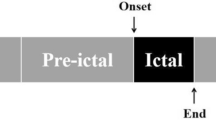Abstract
A long-standing issue in the field of neuroscience is identifying evolving patterns from multivariate electroencephalography (EEG) signals superimposed with intensive noise. With insufficient prior knowledge, it becomes even more important to (1) accurately detect synchronization dynamics among data channels and (2) adaptively classify evolving patterns to better characterize the intrinsic nature of brain activities represented by the EEG. This study uses a shadow-dense network approach to solve these problems. The maximal information coefficient (MIC) method is extended to enable global synchronization measurement of all data channels embedded in the EEG. The global MIC measures are organized in time sequence to represent the evolving synchronization patterns. A shallow-dense neural network is designed to adaptively characterize the nonstationary patterns and then classify them. Experiments are performed to evaluate this approach over an epileptic EEG dataset. It is found that this approach can classify seizure states with accuracy, sensitivity, and specificity of \(97.292\%\), \(98.696\%\), and \(96.116\%\), respectively; these results are superior to those of most existing methods. The proposed approach achieves this performance without denoising the EEG; in contrast, denoising is essential in existing methods. Furthermore, the proposed approach requires only one hyperparameter, which avoids the potential errors caused by excessive parameter settings in existing methods.
Access this chapter
Tax calculation will be finalised at checkout
Purchases are for personal use only
Similar content being viewed by others
References
Gysels E. Phase synchronization for classification of spontaneous EEG signals in brain-computer interfaces. Lausanne EPFL;2006.
Mirowski P, Madhavan D, LeCun Y, Kuzniecky R. Classification of patterns of \(EEG\) synchronization for seizure prediction. Clin Neurophysiol. 2009;120:149–71.
Cui D, Pu W, Liu J, Bian Z, Li Q, Wang L, Gu G. A new \(EEG\) synchronization strength analysis method: S-estimator based normalized weighted-permutation mutual information. Neural Netw. 2016;82:30–8.
Chen D, Li X, Cui D, Wang L, Lu D. Global synchronization measurement of multivariate neural signals with massively parallel nonlinear interdependence analysis. IEEE Trans Neural Syst Rehabil Eng. 2014;22(1):33–43.
Bonita JD, Ambolode LCC II, Rosenberg BM, Cellucci CJ, Watanabe TAA, Rapp PE, Albano AM. Time domain measures of inter-channel EEG correlations: a comparison of linear, nonparametric and nonlinear measures. Cogn Neurodyn. 2014;8:1–15.
Reshef DN, Reshef YA, Finucane HK, Grossman SR, McVean G, Turnbough PJ, Lander ES, Mitzenmacher M, Sabeti PC. Detecting novel associations in large datasets. Science. 2011;334(6062):1518–24.
Iandola FN, Han S, Moskewicz MW, Ashraf K, Dally WJ, Keutzer K. Squeezenet: Alexnet-level accuracy with 50x fewer parameters and \(<\)0.5 MB model size. In: International conference on learning representations, Feb 2017.
Li X, Ouyang G, Richards DA. Predictability analysis of absence seizures with permutation entropy. Epilepsy Res. 2007;77(1):70–4.
Cai C, Zeng K, Tang L, Chen D, Peng W, Yan J, Li X. Towards adaptive synchronization measurement of large-scale non-stationary non-linear data. Futur Gener Comput Syst. 2015;43(44):110–9.
Srivastava N, Hinton G, Krizhevsky A, Sutskever I, Salakhutdinov R. Dropout: a simple way to prevent neural networks from overfitting. J Mach Learn Res. 2014;15(1):1929–58.
Huang G, Liu Z, Weinberger KQ. Densely connected convolutional networks. In: IEEE conference on computer vision and pattern recognition, vol 00; 2016.
Goldberger AL, Amaral LAN, Glass L, Hausdorff JM, Ivanov PCh, Mark RG, et al. PhysioBank, PhysioToolkit, and PhysioNet: components of a newresearch resource for complex physiologic signals, Circulation 101 (23)e215Ce220[EB/OL]. http://physionet.org/physiobank/database/chbmit.
Behnam M, Pourghassem H. Real-time seizure prediction using RLS filtering, interpolated histogram feature based on hybrid optimization algorithm of Bayesian classifier, Hunting search. Comput Methods Program Sin Biomed. 2016;136:115–36.
Fergus P, Hussain A, Hignett D, Al-Jumeily D, Abdel-Aziz K, Hamdan H. A machine learning system for automated whole-brain seizure detection. Appl Comput Inf. 2016;12(1):70–89.
Nasehi S, Pourghassem H. Patient specific epileptic seizure onset detection algorithm based on spectral features and IPSONN classifier. In: International conference on communication systems, network technologies. Gwalior: IEEE;2013. p. 186–90.
Orosco L, Correa AG, Diez P, Laciar E. Patient non-specific algorithm for seizures detection in scalp \(EEG\). Comput Biol Med. 2016;71:128–34.
Author information
Authors and Affiliations
Corresponding authors
Editor information
Editors and Affiliations
Rights and permissions
Copyright information
© 2018 Springer Nature Singapore Pte Ltd.
About this paper
Cite this paper
Ke, H. et al. (2018). A Shallow-Dense Network Approach to Synchronization Pattern Classification of Multivariate Epileptic EEG. In: Jia, Y., Du, J., Zhang, W. (eds) Proceedings of 2017 Chinese Intelligent Systems Conference. CISC 2017. Lecture Notes in Electrical Engineering, vol 459. Springer, Singapore. https://doi.org/10.1007/978-981-10-6496-8_51
Download citation
DOI: https://doi.org/10.1007/978-981-10-6496-8_51
Published:
Publisher Name: Springer, Singapore
Print ISBN: 978-981-10-6495-1
Online ISBN: 978-981-10-6496-8
eBook Packages: EngineeringEngineering (R0)




